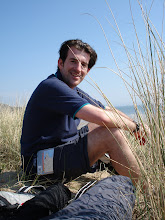We have been slowly working our way down the coast of Athos, intent on following your route to Megalis Lavras (or the Great Lavra). This was the first monastery to be built on Athos in 963AD and is the only monastery not to have suffered a fire in its history.
It sits at the very top of the hierarchy on Athos, and takes the whole pilgrimage thing rather seriously - I fear we might need to up our game. Last night we had sat up planning our route. Sandy had left here by boat, but the journey around the tip of the peninsular is still considered rather dangerous.
The weather can change rapidly, and we had already noticed that the sea was beginning to build with the southerly wind. We were advised that the boat service is often cancelled - the operators agreeing this in advance to save them getting up for work. There was no way we could check this, so we had to have a back-up plan. We had the good fortune to meet an English monk last night, one of only five on Athos (there is also an Australian, but we haven't tracked him down yet). Father Medestos is chiefly responsible for painting icons, and his cell hangs high over the sea on the southern side. He was mid-brushstroke as we arrived, ducking under the low doorway and taking in the incredible view.
We sat and talked with him for a few hours, and he was fascinated in the story of Sandy's escape, and our quest to track down the locations. I gave him a copy of Sandy's letter, which he agreed to pass to the Abbot on his return from the farm at Monexilete. We talked about many things, and it seemed that he enjoyed the opportunity to speak English again. He was of great help in planning our route beyond Lavra. He gave us two likely locations for the boat shed - the first being at Kavsokaliva, and the other at Promodos. Kavsokaliva was an artists commune, he explained, and was at the mid-point of the bottom of the peninsular.
While this fits with Sandy's description, we can't discount Promodos, which lies at the tip closest to the Great Lavra. He understood that this was a Romanian skete (which may fit with Sandy's description of the 'Russian' boatshed) and Lavras also owns houses in the area. As both of these seem to fit, we have decided to cover both on our trip around the bottom end of the peninsular.
The weather wasn't particularly bad first thing in the morning, but it was clear that the wind was building and everyone was uncertain as to the likelihood of the boats running. Father Medestos sought us out just after the church service, and said that the boat was due in the next 30mins. I made the high-risk decision that there was still time for breakfast, and we filed in to the refectory. We threw down our fish and rice, anxious to be first out and to be able to make the boat. It is not that simple, and having finished our food we had to sit there and wait for the readings to end. It was nearly 0830 by the time we got out and raced across the courtyard to get out bags. We must have seemed rather ungrateful as we were out the gate within 2 minutes of breakfast, haring down the slope, through the tunnel and round the back of the monastery to the boatshed. Life on Athos seems to be punctuated by periods of intense activity, followed by long waits.
This 'hurry up and wait' approach struck a chord with the ex-Army members of our team, and they were quite content to sit waiting for the boat to arrive. I was getting rather restless. An hour went by quite slowly. The boat was overdue, which was not a good sign. Pilgrims were starting to walk up the steep path heading to Dafni, which wasn't a good sign. We had exhausted all entertainment. Tyson had eaten almost every snack he had in his rucksack. Alun had won at stone skipping, and I had explored the boatshed and slipway twice! It was time to put our back-up plan into operation. Dionysiou remains one of the few monasteries not connected to the road network.
It is probably only a matter of time, as we could hear heavy earthmovers at work high up in the gorge behind the monastery. If we wanted evacuation by truck, we would have to continue down the coast to Aghia Pavlo (St Paul's Monastery). On went the rucksacks, and we trudged back up the slope and into the monastery - starting a minor panic as people thought the boat had arrived. The path to St Pauls was dicey - in places quite narrow and terrifically exposed. It didn't help that the rain had begun, making the rocks quite greasy. We adopted a slow but sure pace, and soon crossed the highest point and could see a large ruined tower on the beach in the next bay.
It took a while to lose height, Tyson taking the lead down the jumbled path and on to the ruined building. The monastery sat above us, and as we commenced the long walk up the hill, I reminded Tyson that this was also one of Sandy's haunts. By now the rain was really chucking it down, and the wind was whipping around our heads, making things thoroughly miserable. It was a good half hour before we arrived wringing wet at the door of St Pauls. We still had an enormous distance to cover, and things were not looking bright.
The monastery of St Pauls may not be as immediately impressive as Simonas Petra, but it had warm radiators and served coffee, which puts it pretty high on my list. We were glad to strip off our wet clothes, and soon converted the guesthouse into a chinese laundery. The monks were very good about it, serving us drinks and helping us locate a taxi company in Karyes. They reckoned they could be with us in 1hr, and the cost would be... 100 Euros!!! (cue sharp intakes of breath and rapid calculations by John, the kitty holder).
If we were to stay on track, we didn't have a choice. The hour became nearly three, and we all got cold and wet again. Whose bright idea was it to wait outside in the rain? Luckily a monk took pity on us and ushered us into a nearby workshop. He was another Englishman, who had been at the monastery for nearly 20 years. It was strange to meet two Englishmen in quick succession. The minibus duly arrived, and we loaded kit and set off. It was a horrific experience - the rain had washed rocks down onto the road, and deep orange torrents crossed the road at every corner.
Our driver possessed magical powers, thrashing the engine to maintain speed on the treacherous route - at times there was less than a foot between us and a long drop to the sea. We kept very still, and even Tyson lost his grin. The weather worsened as we went on. At times the rain fell so heavily that the windscreen wipers couldn't cope. The torrents had grown, and the driver hesitated at each one before roaring across. By now he had finished his second can of beer, and was getting into his stride. It was with great relief that we finally emerged on the northern coast. The weather this side seemed much worse - the sea was in a furious swell, and a long smear of orange in the water showed the quantity of water being sluiced off the hills. The monastery finally appeared on the headland in front of us, a vast spread of buildings, walls and rooftops.
We screeched to a stop outside the main gate, and staggered off - grateful to have survived an epic drive. We raced to the guesthouse, where the guestmaster advised us to run to the refectory as the meal was already under way. Tyson led the charge, and nearly cannoned into the Abbot who flung open the doors as we arrived! After all that, we managed to get some food, and we are now in the guesthouse. The rain is still falling hard, running off the roofs and creating quite a racket.
We have made it to the Great Lavra - tomorrow we search for the attic!
Wednesday, 4 November 2009
Subscribe to:
Post Comments (Atom)


No comments:
Post a Comment